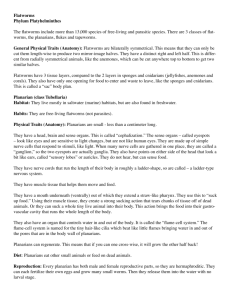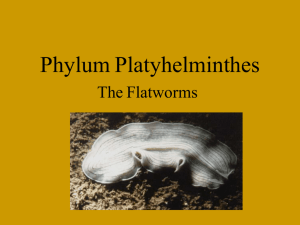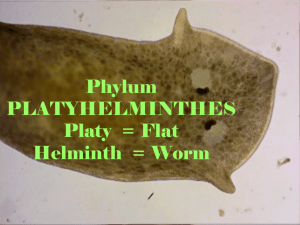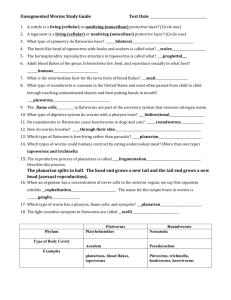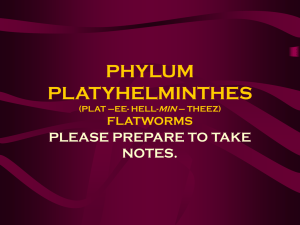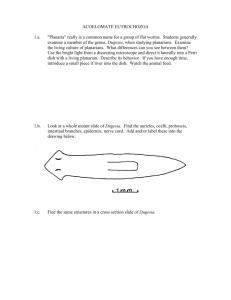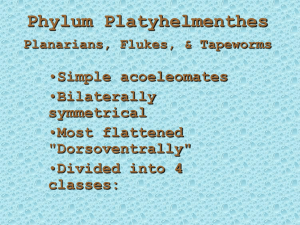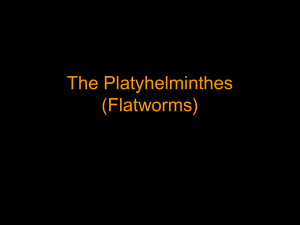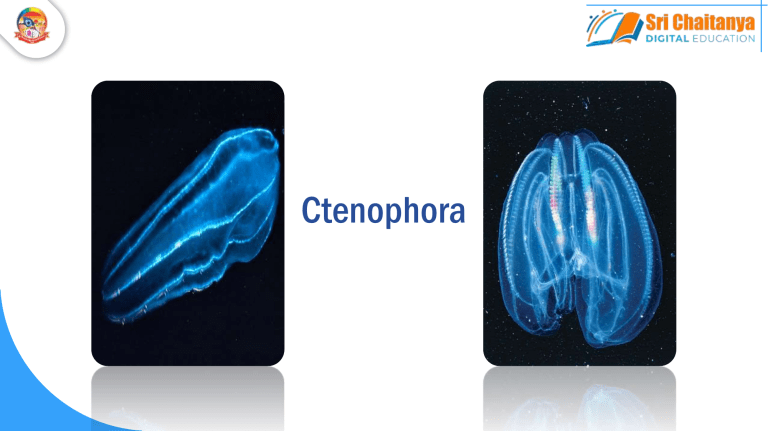
Ctenophora Did you know? • Tapeworms can be in sizes longer than a bus. • Largest one found is 90 feet. • Flatworms can stick its pharynx into their prey, like a vacuum cleaner hose and suck out the prey’s insides. • The deep-sea species of comb jellies are so fragile that, they cannot be collected for examination. Ctenophora • Commonly known as sea walnuts or comb jellies • Also called sea gooseberries. • Transparent, gelatinous unsegmented animals. • Formerly included under Coelenterata, along with cnidarians. Habitat Exclusively marine. Habit • All are solitary and free-swimming animals. Diploblastic Tissue level of organization. Symmetry Radial • Most of the structures are radially arranged but tentacles are paired (biradial). Colloblasts • • • • • Lasso cells Present on the surface of the tentacles Secrete a sticky substance Facilitate prey capture Ctenophores lack cnidoblasts Comb plates • The body bears eight external rows of ciliated comb plates, which help in locomotion. Digestion • • • The gastrovascular cavity consists of a pharynx, stomach, and a system of gastrovascular canals. The gastrovascular cavity ends in two aboral anal pores. Digestion is both extracellular and intracellular. Respiration Occurs by diffusion through the body wall. Excretion • Occurs by diffusion through the body wall. Bioluminiscence The property of a living organism to emit light is well-marked in ctenophores. Coordination • Thy have a nerve net system similar to that of cnidarians. • Statocyst is present. Reproduction • Reproduction takes place only by sexual means. • Sexes are not separate. • Fertilization is external. • Development is indirect • Larva is cydippid larva. • Regeneration is common. Classification Ctenophora Tentaculata Adults possess two aboral tentacles Examples: Pleurobrachia Ctenoplana Hormiphora Nuda Tentacles are absent Example: Beroe Affinities of Ctenophores Differences with Cnidaria Similarities with Cnidaria • • • • • • Diploblastic condition Tissue level of organisation Presence of coelenteron Extracellular & intracellular digestion External fertilization Indirect development • Absence of cnidocytes • Monoecious nature • Absence of asexual reproduction Unique Features • Comb plates • Lasso cells Platyhelminthes Common Forms Platyhelminthes (Flatworms) Turbellaria (Planarians) Trematoda (Flukes) Cestoda (Tapeworms) Dugesia Fasciola Taenia Body Form They have dorso-ventrally flattened body, hence are called flatworms. • Greek platys = flat; helmins = worm Eggs Proglottid Transverse Section Eggs Habits These are mostly endoparasites found in animals including human beings. • Planarians are free-living. Level of Organisation Flatworms are bilaterally symmetrical, triploblastic and acoelomate animals with organ level of organisation. Symmetry Flatworms are bilaterally symmetrical, triploblastic and acoelomate animals with organ level of organisation. Body Covering Planarians Flukes Tapeworms Ciliated epidermis with mucus producing rhabdites Tegument Tegument Acoelomate Condition Flatworms are bilaterally symmetrical, triploblastic and acoelomate animals with organ level of organisation. • They have a solid bauplan. • Space between the gut and the body wall is filled with parenchyma. Organs of Anchorage Hooks and suckers are present in the parasitic forms. Planarians Flukes Tapeworms Free-living Parasitic Parasitic No hooks and suckers Suckers Hooks & suckers, rostellum Organs of Anchorage • In flukes, two suckers are present • Oral sucker • Ventral sucker (acetabulum) Organs of Anchorage • In tapeworms, scolex bears • Rostellum • Hooks • Suckers Digestion Incomplete gut (blind sac body plan). • Mouth is used for ingestion and egestion. • Anus is absent. Some of them absorb nutrients from the host directly through their body surface. • Tapeworms absorb nutrients through the tegument (parasitic mode of nutrition). Respiration and Circulation • Respiratory and circulatory systems are absent. • Parenchyma helps in circulation of substances. Excretion Specialised cells called flame cells help in osmoregulation and excretion. • Protonephridia with flame cells are useful primarily for osmoregulation and secondarily for excretion. • Ammonotelic Nervous Coordination • Cerebral ganglia constitute the brain. • Longitudinal nerve cords are joined by transverse commissures at regular intervals giving a ladder-like appearance. • Sense organs are common in turbellarians • Sense are greatly reduced in trematodes and cestodes (parasitic forms). Reproduction and Development Sexes are not separate. • Schistosoma haematobium is unisexual. Fertilisation is internal. (copulatory organ is present) Development is through many larval stages. • Polyembryony is common in flukes. Planarians Muller’s larva Flukes Miracidium, Cercaria, etc. Tapeworms Hexacanth, Cysticercus (bladderworm) Life cycle of Fasciola (digenetic parasite) • Miracidium larva (forms in sheep; infective stage to intermediate host) • Sporocyst (parthenogenetic) • Redia (parthenogenetic) • Cercaria larva • Metacercaria, (forms in snail; infective stage to primay host) • Adult stage. Life cycle of Taenia (digenetic parasite) Regeneration Some members like Planaria possess high regeneration capacity. In Planaria (flat worms), we observe true regeneration, i.e., a fragmented organism regenerates the lost part of its body and becomes, a new organism (NCERT; Living World). • Many turbellarians reproduce asexually. Metazoan features that appeared first in Platyhelminthes Triploblastic condition Unidirectional movement Mesoderm Cephalization (moderate) True muscle tissue Digestive system Organ/organ-system level Excretory system Bilateral symmetry Brain Examples Dugesia Planarian Fasciola hepatica Liver fluke Fasciolopsis buski Intestinal fluke Schistosoma haematobium Blood fluke Taenia solium Pork tapeworm Taenia saginata Beef tapeworm Echinococcus granulosus Dog tapeworm Dugesia Fasciola hepatica Fasciola hepatica Taenia solium Schistosoma haematobium Echinococcus granulosus
